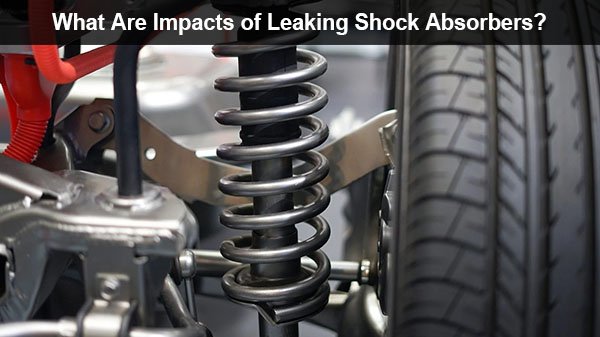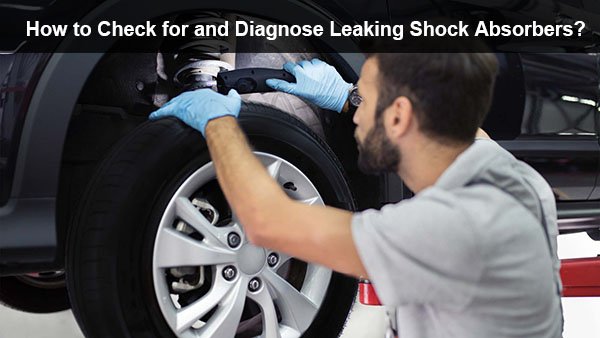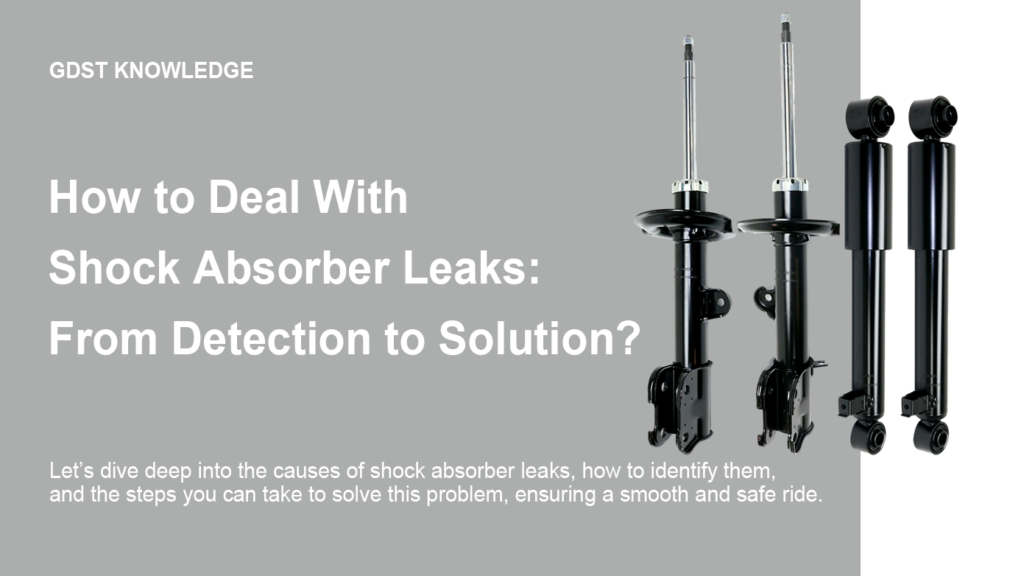Have you ever wondered why your vehicle suddenly starts to feel bumpier and less comfortable than usual? The culprit might be leaking shock absorbers, a common yet overlooked issue that can significantly impact your driving experience. In this article, we’ll dive deep into the causes of shock absorber leaks, how to identify them, and the steps you can take to solve this problem, ensuring a smooth and safe ride.
When shock absorbers leak, it’s generally due to the failure of the top seal. Shock absorbers are filled with hydraulic fluid, internal seals, and some mechanical valves, which are all very precise and easy to wear out and break down.
To understand why this is important, let’s take a closer look at the role of shock absorbers and the signs that might indicate a leaking problem.
What Causes Shock Absorber Leaks?
Shock absorber leaks can be caused by several reasons, which will affect vehicle performance and safety. Here are the common causes of shock absorber leaks:

- Wear and Tear: The most common reason for shock absorber leaks is natural wear and tear. The seals that keep fluid inside the shock absorbers will wear out and crack over time and regular use.
- Damage from Road Conditions: Potholes, rough roads, and debris can cause physical damage to the shock absorbers. Impacts can puncture or dent the shock absorber’s body, or damage the seals, leading to fluid leaks.
- Corrosion: The shock absorber’s body may be corroded due to water, road salts, and some other corrosive substances. Corrosion will eat through the metal, causing leaks.
- High Pressure: Shock absorbers work under high pressure, and this pressure will weaken or damage the seals over time, leading to leaks.
- Faulty Installation or Incorrect Type: If shock absorbers are not installed correctly, it will cause premature wear or damage. Using the wrong type of shock absorber for the vehicle or driving conditions will also increase the possibility of leaks.
- Manufacturing Defects: In some cases, leaks are caused by defects in the manufacturing process of the shock absorber, such as faulty seals or improper assembly.
- Age: As vehicles age, the components, including shock absorbers, will degrade. The materials will become brittle and less effective at retaining fluid, leading to leaks.
What Are Signs of A Leaking Shock Absorber?
The leaking shock absorber can affect the comfort and safety of your ride, so it’s important to recognize them early. Here are the common signs of leaking shock absorbers:

- Visible fluid leaks: You can see fluid leaking down the side of the shock absorber. The fluid is usually clear or slightly oily.
- Poor ride quality: Your vehicle feels more bouncy or unstable on the road, especially over bumps and potholes. The loss of fluid reduces their ability to dampen the vehicle movement.
- Unusual noises: Knocking or banging noises from the suspension when you drive over bumps. The shock absorbers do not function correctly.
- Uneven tire wear: The shock absorbers are leaking, causing uneven or excessive tire wear. The tires bounce and lose contact with the road.
- Vehicle sways or leans on turns: Your vehicle sways or leans more than usual during turns or changing lanes. The shock absorbers are leaking, which leads to the loss of stability.
- Longer stopping distances: It takes a longer time for your vehicle to stop. The shock absorbers are leaking, and the tires cannot keep in contact with the road.
- Visible damage to the shock absorbers: Except for fluid leaks, you can see dents or corrosion on the shock absorbers. They suggest potential or existing leaks.
- Dipping or diving when braking: The front end of your vehicle dips significantly when braking. The shock absorbers are leaking, and they do not function correctly.
The Impact of Leaking Shock Absorbers on Vehicle Performance
Leaking shock absorbers can have a significant impact on the performance and safety of vehicles. It is not just a matter of one aspect of driving but concerns various critical areas.

- Reduced Handling and Stability: Shock absorbers play an important role in maintaining the stability and handling of vehicles. Once leaking, the shock damping will be reduced, resulting in excessive body roll in corners, poor steering response, and instability, especially at high speeds or in windy conditions.
- Increased Wear on Suspension Components: If the shock absorbers fail to work properly due to leaks, other parts of the suspension system, such as springs, bushings, and joints, will be subjected to more stress and wear. This may lead to premature failure of these components, and result in costly repairs.
- Braking Efficiency Reduced: Shock absorbers are designed to keep the tires in contact with the road. If they leak, the tire will bounce off the road, and the braking distance will be increased. It is dangerous because the braking traction will be reduced, especially in emergency stopping.
- Tire Worn and Damaged: Leaking shock absorbers will cause the tire to bounce, and the tire-to-road contact will be less consistent. This will result in tire wear with uneven patterns and a shorter life. If the tire loses grip or fails, the driving condition will be dangerous.
- Comfort Decreased: The comfort of the ride will be compromised. The vehicle will feel excessively bouncy or harsh over bumps and potholes. It will be an uncomfortable and fatiguing driving experience.
- Safety Risks: The leaking shock absorbers have the most influence on the safety of the vehicle. The vehicle’s handling is reduced, the stopping distance is longer, and the stability in bad road conditions is lower. All of these may increase the risk of accidents.
- Increased Fuel Consumption: In some cases, the leaking shock absorbers may increase fuel consumption. The bouncing and instability of the vehicle will change the aerodynamics, and the engine will work harder to maintain the speed. As a result, the fuel efficiency is decreased.
How to Check for and Diagnose Leaking Shock Absorbers?
Checking for and diagnosing leaking shock absorbers is crucial for maintaining your vehicle’s performance and safety. Here’s a step-by-step guide on how to perform this inspection:

Visual Inspection
- Park on a Level Surface
Please park your vehicle on a flat and level surface. Turn off the engine. Apply the parking brake for safety. - Look for Visible Leaks
Inspect each shock absorber to see if there is any fluid leakage. Usually, shock absorbers are located near the wheels. Please check if there are any wet or oily residues on the shock absorber body, especially around the seals where the shaft meets the cylinder. - Check for Physical Damage
Please check if there is any physical damage to the shock absorbers, such as dents, corrosion or excessive rust. These damages may cause the shock absorber to leak.
Bounce Test
- Do a Bounce Test: Press down hard on each corner of the car and release. The car should bounce back once and return to its original position. If the car keeps bouncing more than once or twice, it may mean the shock absorber is worn or leaking.
Road Test
- Listen for Noises:
Drive your vehicle over bumps or uneven surfaces at a safe speed. Listen for any unusual noises coming from the suspension, such as knocking or banging, which can indicate a problem with the shock absorbers. - Feel the Ride Quality:
Pay attention to how your vehicle handles bumps and corners. A noticeable increase in bounce, sway, or a generally unstable feeling can suggest that the shock absorbers are not performing correctly.
Professional Inspection
- Ask for Professional Help: If you’re not sure or if your preliminary check shows something wrong, it’s better to ask a professional mechanic to inspect the vehicle. They can do a more detailed check, including checking the leakage you missed and the condition of the whole suspension system.
Regular Maintenance
- Regular Maintenance Checks: Include shock absorber checks as part of your regular vehicle maintenance routine. Early detection of leaks or damage can prevent more severe issues down the line.
Repair or Replace? Making the Right Decision for Leaking Shock Absorbers
Deciding whether to repair or replace leaking shock absorbers depends on several factors, including the extent of the damage, the age and condition of the vehicle, and cost considerations. Here’s how you can make an informed decision:

Check the Damage Range
- Minor Leakage: If the leakage is minor and shock absorbers are relatively new or in good condition, a professional mechanic could repair them. But it’s seldom happened, because most shock absorbers are sealed.
- Significant Damage or Wear: For significant leakage, physical damage, or shock absorbers that are worn seriously, it’s recommended to replace them. If you continue to drive with damaged or worn-out shock absorbers, it will cause safety problems and damage your suspension system.
Consider the Age and Condition of the Vehicle
- Newer Vehicles: If your vehicle is relatively new or in excellent overall condition, it is often worth investing in new shock absorbers to maintain optimal performance and safety.
- Older Vehicles: For older vehicles, especially those close to the end of their service life or with multiple existing issues, the cost of replacement might not be justifiable. However, safety should always be a priority, so even in older vehicles, replacing failing shock absorbers may be necessary.
Evaluate Cost Implications
- Repair Costs: Repairing shock absorbers, if available, may seem like a cost-effective solution at first. However, most shock absorbers are sealed and designed to be replaced rather than repaired. It is not easy to find a repair solution and it is not cost-effective in the long run.
- Replacement Costs: Although it will cost more to replace the shock absorbers in the beginning, it is often the most economical choice in the long term. The new shock absorbers will bring back the ride quality, improve safety, and prevent additional wear on tires and suspension parts.
Consult with Professionals
Consult with a professional mechanic or suspension specialist before making a decision. They can give you a detailed assessment of your shock absorbers and suggest the best choice based on safety, performance, and value for money.
Conclusion
To sum up, it is very important to deal with shock absorber leaks on time. By understanding the reasons, recognizing the signs, and knowing when to repair or replace, you can always keep your vehicle in good condition and drive safely.
For more automotive insights and tips, please stay tuned and don’t hesitate to reach out to us with your questions or experiences about shock absorber leakage.






